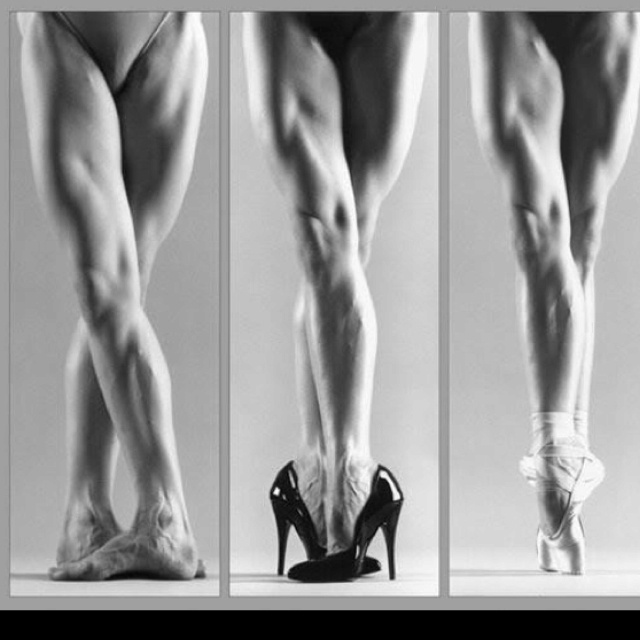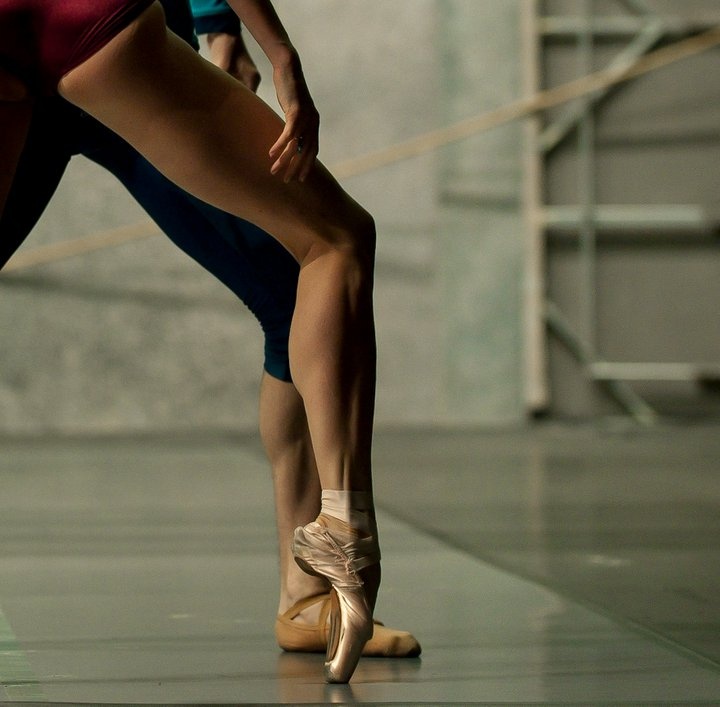How to get dancers legs
6 Moves for Great Dancer Legs
Want to get a major case of leg envy? Just check out a dancer—they always have amazingly sexy stems. But believe it or not, they don't come from dancing alone. “Dancing is great exercise, but it's primarily cardio,” says Akua Noni Parker, a professional dancer and member of the Alvin Ailey American Dance Theater Company. Parker, who has been dancing since the age of three, has performed on stages around the world. Now, you can catch her (and her awesome legs) in action at New York City's Lincoln Center from June 12-16, where she’ll be performing in the acclaimed show Revelations, among others.
These six moves, which Parker does daily, will get your legs in show-off shape, too—even if you have two left feet. “These exercises hit major leg muscles like your quads, hamstrings, and calves—but also target your core and glutes and help with hip stabilization,” says Karen Joseph, a personal trainer and owner of Fountain of Fitness in Valrico, Florida. Pick a few of your faves and add them to any workout—or do all six exercises as one circuit two or three times a week.
Pelvic raises Lie down on your back with your knees bent, feet hip-width apart and resting flat on the floor. Then raise your hips so your body forms a straight line from your shoulders to your knees. Pause, then lower back to the starting position. Repeat slowly 30 times. Position your feet a few inches further away from your body and repeat.
Squats Stand with your feet shoulder-width apart, and lower your body a far as you can by pushing your hips back and bending your knees (while keeping your knees above your ankles). Pause, then push through your heels to return to start. Do 20 reps, then turn your toes out (as if you're doing a plie) and repeat.
Calf raises Hold onto a wall with your feet parallel, hip-width apart. Keep your knees straight and rise up onto your toes as high as you can. Pause, then slowly lower back to the floor. Do 15 reps, and then turn your toes out, heels together, and repeat.
Do 15 reps, and then turn your toes out, heels together, and repeat.
Clams Lie on your left side on the floor, with your hips and knees bent 45 degrees. Your right leg should be on top of your left leg, and your heels should be stacked together. Keeping your feet in contact with each other, raise your right knee as high as you can without moving your pelvis. Pause, then return to the starting position. Don't allow your left leg to move off of the floor.
Single-leg lift Get on your hands and knees and raise one leg off the ground so it’s in line with your body. Your back should be flat, core tight, foot flexed (imagine you’re trying to reach your heel toward the wall behind you). This is the starting position. Keeping your leg straight and, without arching your back, squeeze your glute and raise your leg a few inches toward the ceiling. Pause, then lower back to the starting position. Do 10, then repeat on the other side.
Fire hydrant in-out Start on your hands and knees, then raise your right knee off the ground and bring it toward your chest, keeping your back flat. Keeping your right knee bent, raise your thigh out to the side without moving your hips. Slowly lower back to start. Do 10, then repeat on the other side.
Keeping your right knee bent, raise your thigh out to the side without moving your hips. Slowly lower back to start. Do 10, then repeat on the other side.
photo: Alvin Ailey American Dance Theater Company
More From Women's Health:
Get Into the Groove: The Benefits of Dance
Get Sexy Summer-Ready Legs Like J.Lo
Get Lean Legs
Strength Training For Dancers - Elite Dance Studio
Dance is one of the most fast-paced, demanding and dynamic activities your body can do– for this reason, dancers are world renowned for both their athletic prowess and their physical beauty. Dancing not only strengthens and tones your body, it transforms your posture and adds grace to even the most mundane of movements. Whether you are hitting the ballroom or your living room, there are simple exercises that you can do almost anywhere to gain the long, lean muscles needed for dance. Read on for Elite Dance Studio’s guide to strength training for dancers… Leg day edition!
Read on for Elite Dance Studio’s guide to strength training for dancers… Leg day edition!
BALLET TRAINING
Among dancers, ballet training is known to be among the most grueling– but the results are undeniable! Most people grow up knowing ballet dancers are the pinnacle of graceful strength, so why not follow their example? Ballet or ballet-inspired exercises and stretches are ideal for adding flexibility and strength to your lower half.
SQUATS & LUNGES
Squats and lunges have become popular across all kinds of popular fitness. It is for good reason! These exercises isolate and strengthen your quads, calves, hamstrings and glutes– basically your butt and legs, essential muscles for strong dancers. Another great feature is that they require no equipment, relying entirely on your body weight and proper posture. From your backyard to the office: try a set or two of squats and lunges anywhere!
WALL-SITS
This next exercise does require one thing besides a willing participant: a wall! Sit against a wall with your legs planted evenly at a 90-degree angle and you will feel the burn in no time..jpg) Wall-sits are a classic conditioning exercise for dancers, building both muscle strength and endurance. Like squats and lunges, these can be done almost anywhere and they support the lower trunk of your body.
Wall-sits are a classic conditioning exercise for dancers, building both muscle strength and endurance. Like squats and lunges, these can be done almost anywhere and they support the lower trunk of your body.
LEG LIFTS & RAISES
Staying with the theme, other popular exercises among dancers are leg lifts and raises. Leg lifts can be done lying on your back by raising each leg, making sure to keep it straight while tightening your abdominal muscles. Leg or calf raises can be done on a stair, low bench, curb… Anywhere really! Simply stand with your heels hanging over the edge and stand up on your tiptoes, keeping your back, legs and core in a straight line. As with all of the above, a dancer’s posture– head up, shoulders back– will add to the impact of the exercise.
ABDOMINAL EXERCISES
All dancers train their core (abdominal muscles), but it may be hard for the layman to understand how that helps your legs. Strength should originate from your core, as it will add power and explosiveness to any motion. A well-trained athlete knows that strong abdominals will lengthen your entire body and allow your legs to become more toned, among other benefits.
A well-trained athlete knows that strong abdominals will lengthen your entire body and allow your legs to become more toned, among other benefits.
The outline above is just a starting point for anyone seeking to pursue strength training for dancers, whether they want to dance professionally or not. Elite Dance Studios caters to students of all skill levels, focusing on the fundamentals of building a dancer’s body– and the joy of dance most of all! Contact or visit us today for more information.
4 steps to perfect dancer's legs
- Dec 16, 2014
- DANCE-mania, Blog, Video, Health, Exercise
Dancer's feet. They are not just long and thin. They are strong. They are flexible. And they do not appear easily by themselves.
This article contains four basic exercises that work your legs from top to bottom, with which you can achieve the perfect dancer's legs.
Trust the experts!
1. Glutes and Hamstrings - Marching leg raises, leaning on the ball.
Strong buttocks not only allow you to move faster and more vigorously, but also help prevent injuries to your knees and lower back.
Lie on your back face up with your knees bent and your feet on a large ball. Raise your hips so that your body forms a straight line from your shoulders to your knees (A). Raise one knee to your chest (B). Then lower back, lift the other knee. Continue the exercise by changing legs.
2. Inner thigh - squats (Standing Plié Squat).
The muscles of the inner thigh, like all other muscles of the upper leg, help stabilize the knee joint. And when it comes to turnout, many dancers try to work from the knee. Strong inner thigh muscles will help you turn your legs exactly where you want them to.
Begin the plie exercise in wide second position, hands in second position with palms up.
Corn the buttocks and muscles of the inner surface of the thigh, getting up and raising your hands over your head.
Return to starting position and do 3 sets of 10 reps at a fast pace.
Let's make it harder! At the end of each rep, hold the plié and do 20 small up and down pulsating movements.
For maximum effect, stay in plie and pulse forward with 20 knees.
for advanced ones: at the end of each series, rub the heel from the floor and squeeze the hip muscles, go up to the half -packages and linger in 10 accounts.
During the exercise, make sure that the muscles of the lower body are involved and that the hips are always kept directly under the shoulders.
For some, this exercise is old hat, but for us it is a classic. The toe raise strengthens both parts of the calf - the calf (the one you usually see on the back of the leg below the knee) and the soleus (which is under it). The next time you're balancing on your toes in a dance studio and trying to reach something on the top shelf, thank your strong calves.
A. Stand next to a chair with your heels together and toes apart. Place your right hand on the back of a chair, your left hand on your belt.
B. Slowly rise up on your toes. Hold at the top for a few seconds, then lower your heels. Repeat 10-15 times.
Be sure to stretch after strengthening exercises!
And finally, inspiring photos of beautiful dancing legs!
Share:
How to properly care for the feet of flamenco dancers?
A flamenco dancer's legs are subjected to heavy stress during the performance of fractions, rotations and sudden changes in movement. Flamenco classes help the legs become strong, toned and beautiful, but this does not mean that the legs do not need additional care. Today we will talk about the rules for the care of the feet of dancers to maintain the beauty and health of the legs.
Flamenco classes help the legs become strong, toned and beautiful, but this does not mean that the legs do not need additional care. Today we will talk about the rules for the care of the feet of dancers to maintain the beauty and health of the legs.
- Flamenco classes should be attended with warm (preferably woolen) gaiters.
Socks help to warm up muscles and tendons faster during warm-up, so the chance of pulling muscles or damaging joints is minimized.
Today, the variety of leggings is so great that every flamenco dancer can easily find a model to his taste. Gaiters are: colorful and plain, long and short, dense and with a beautiful openwork pattern.
Gaiters keep you warm, but don't make your feet sweat!
Gaiters need to be washed frequently, so an easy-care model is preferable. The threads should be natural - cotton or wool, then they will "breathe" and better warm the flamenco dancer's leg. If you choose mixed leggings, then they must be at least 50% wool and cotton. This version of the leggings is easier to wash and dries faster.
This version of the leggings is easier to wash and dries faster.
- Don't forget about daily foot hygiene.
One of the first rules of foot care not only for flamenco dancers, but for all people is cleanliness. Feet should be washed every day with warm water and soap or other cleanser. After the bath, the legs are wiped dry with a towel. If the dancer has excessive sweating, you can use talcum powder or baby powder, and use deodorant for shoes and feet. A decoction of oak bark for wiping the feet is very popular among flamenkists. The recipe is very simple. Pour two tablespoons of crushed oak bark with two glasses of water, boil for 10-15 minutes, cool and filter. Oak bark can be replaced with willow bark, alder cones, hazel, mint, lime blossom, elderberry leaves.
Don't forget the foot brush and pumice stone to get rid of rough skin and give your feet a healthy and fresh look.
- Use of special creams and ointments.

- After showering, dancers should use muscle warmers. For example, a mixture of troxevasin or lyoton ointment with a moisturizer in a one-to-one ratio will help you forget about swollen legs and spider veins. An excellent option would be a combination of snake venom and woolen socks.
So that the skin on the legs is soft and delicate without cracks, you need to moisturize it with a cream. A simple baby fat cream will do.
- Leg exercises. After the legs of the flamenco dancer are rubbed with ointments and dressed in woolen socks, the following exercise can be done to completely relax the legs. Walk in small, rolling steps from heel to toe for 15 minutes, then lie down and put your feet on the wall in a position of medium comfort. The blood will gradually move away from the legs. After 7 minutes, slowly lower them, first bending at the knees. Then straighten lying down and fall asleep. It is advisable to do this every day to prevent the dancer's legs from getting sick.












